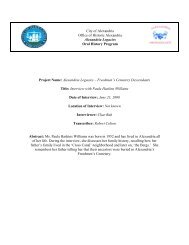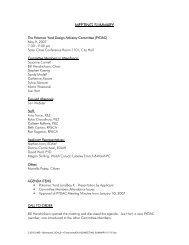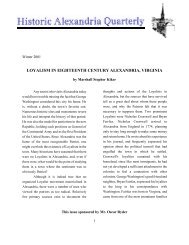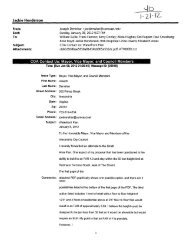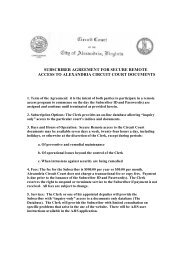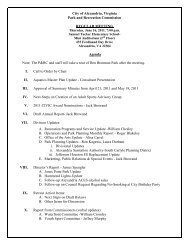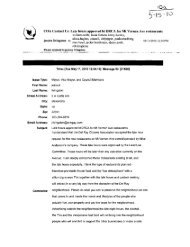Potomac Waterfront Flood Mitigation Study - City of Alexandria
Potomac Waterfront Flood Mitigation Study - City of Alexandria
Potomac Waterfront Flood Mitigation Study - City of Alexandria
You also want an ePaper? Increase the reach of your titles
YUMPU automatically turns print PDFs into web optimized ePapers that Google loves.
Overview <strong>of</strong> <strong>Flood</strong> <strong>Mitigation</strong> Measures<br />
To receive CRS full credit <strong>of</strong> 45 points, the community must have a system to track<br />
improvements for at least 10 years. However, <strong>Alexandria</strong> could receive 25 CRS points if the<br />
records are accessible for at least five years.<br />
This element may require no specific ordinance language, but simply a policy decision to<br />
interpret the 50 percent improvement threshold as cumulative. In such cases, as required by<br />
the CRS program, documentation must include a legal opinion or directive from the legal<br />
counsel stating how the ordinance is to be interpreted. In any event, the <strong>City</strong> would need to<br />
maintain permit records by parcel number or address, so that the history <strong>of</strong> improvements or<br />
repairs to a particular structure is checked before the next permit is issued.<br />
This element requires that more structures be brought into compliance with the NFIP, thereby<br />
lowering costs from flood damages and decreasing flood insurance rates. There will be an<br />
increased cost for homeowners and business owners who reach the substantial improvement<br />
threshold earlier and will be required to bring their structures into compliance with the<br />
floodplain regulations. For the <strong>City</strong>, costs would be associated with changing the zoning<br />
ordinances and policies and educating permitting <strong>of</strong>ficials on the change.<br />
However, one difficulty expressed by the <strong>City</strong>’s staff is evaluating the value <strong>of</strong> the<br />
improvement in comparison to the value <strong>of</strong> the structure. The <strong>City</strong>’s current ordinance is<br />
written based on NFIP requirements, which calculate the improvement as a percent <strong>of</strong><br />
“market value <strong>of</strong> the structure.” If the <strong>City</strong> were to change the definition within the ordinance<br />
to reflect different measurement criteria, such as square footage, the change may not meet<br />
NFIP requirements. Therefore, it is recommended that the <strong>City</strong> consult with FEMA regarding<br />
the method <strong>of</strong> measuring cumulative improvement values.<br />
Lower Substantial Improvements – This element has the effect <strong>of</strong> requiring more<br />
structures to come into compliance after a disaster, because damage repair is included in<br />
"improvements" under the NFIP rules. The <strong>City</strong> <strong>of</strong> <strong>Alexandria</strong> already includes a 50 percent<br />
substantial improvement threshold. To receive CRS credit for the Lower Substantial<br />
Improvement Threshold, the <strong>City</strong> would need to lower the threshold to less than 50 percent.<br />
For instance, if the regulatory threshold was lowered to 49 percent, the <strong>City</strong> would qualify<br />
for an additional 10 points. If the threshold was lowered to 39 percent, the <strong>City</strong> would qualify<br />
for an additional 50 points.<br />
In a manner similar to the cumulative substantial damages element, this element provides<br />
more flooding protection by requiring more structures be brought into compliance with the<br />
NFIP, thereby lowering costs from damages and decreasing flood insurance rates. However,<br />
it results in an increased cost for homeowners and business owners who reach the lower<br />
substantial improvements threshold earlier and will be required to bring their structures into<br />
compliance with the flood maps. Again, the only costs to the <strong>City</strong> would be associated with<br />
changing the zoning ordinances if necessary and educating permitting <strong>of</strong>ficials on the<br />
change.<br />
Protection <strong>of</strong> Critical Facilities – CRS credit is provided only if regulatory language<br />
protects critical facilities. FEMA defines types <strong>of</strong> critical facilities as follows:<br />
Structures or facilities that produce, use, or store highly volatile, flammable, explosive,<br />
toxic and/or water-reactive materials<br />
28-JUL-10\\ 3-9





